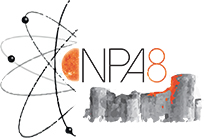Speaker
Jeffery Blackmon
(Louisiana State University)
Description
%
% Nuclear Physics in Astrophysics 8 template for abstract
%
% Format: LaTeX2e.
%
% Rename this file to name.tex, where `name' is the family name
% of the first author, and edit it to produce your abstract.
%
\documentstyle[11pt]{article}
%
% PAGE LAYOUT:
%
\textheight=9.9in
\textwidth=6.3in
\voffset -0.85in
\hoffset -0.35in
\topmargin 0.305in
\oddsidemargin +0.35in
\evensidemargin -0.35in
%\renewcommand{\rmdefault}{ptm} % to use Times font
\long\def\TITLE#1{{\Large{\bf#1}}}\long\def\AUTHORS#1{ #1\\[3mm]}
\long\def\AFFILIATION#1#2{$^{#1}\,$ #2\\}
\begin{document}
{\small \it Nuclear Physics in Astrophysics 8, NPA8: 18-23 June 2017, Catania, Italy}
\vspace{12pt}
\thispagestyle{empty}
\begin{center}
%%%
%%% Title goes here.
%%%
\TITLE{Studies of X-ray burst reactions with radioactive ion beams from RESOLUT}\\[3mm]
%%%
%%% Authors and affiliations are next. The presenter should be
%%% underlined as shown below.
%%%
\AUTHORS{J. C. Blackmon$^{1}$, M. Anastasiou$^{2}$, L.~T.~Baby$^{2}$, J.~Baker$^{2}$, J. Belarge$^{2}$, K.~Colbert$^{3}$, C.~M.~Deibel$^1$, H.~E.~Gardiner$^1$, D.~L.~Gay$^3$, E.~Good$^1$, P.~H\"oflich$^2$, A.~A.~Hood$^1$, K.~Joerres$^1$, N.~Keely$^4$, S.~A.~Kuvin$^2$, J. Lai$^1$, A.~Laminack$^1$, L.~E.~Linhardt$^1$, J.~Lighthall$^1$, K.~T.~Macon$^1$, E. Need$^1$, N. Quails$^4$, B.~C.~Rasco$^1$, N. Rijal$^2$, A. Volya$^2$, I. Wiedenh\"over$^2$}
%%%
{\small \it
\AFFILIATION{1}{Louisiana State University, Baton Rouge, LA 70803 USA}
\AFFILIATION{2}{Florida State University, Tallahassee, FL 32306 USA}
\AFFILIATION{3}{University of North Florida, Jacksonville, FL 32224 USA}
\AFFILIATION{4}{National Center for Nuclear Research, Otwock, Poland}
}
%%%
\vspace{12pt} % Do not modify
% Enter contact e-mail address here.
\centerline{Contact email: {\it blackmon@lsu.edu}}
\vspace{18pt} % Do not modify
\end{center}
%%%
%%% Abstract proper starts here.
%%%
X-ray bursts are the most common stellar explosions in the Galaxy, occurring in binary systems when hydrogen-rich
matter from a main-sequence star accretes onto a neutron star and ignites in a thermonuclear runaway.
Simulations of these events show that
particular nuclear reactions involving
proton-rich radioactive nuclei have a direct impact on energy generation, nucleosynthesis, and astronomical observables. [1,2]
The rates of many of these reactions have large uncertainties due experimental challenges in studying the properties of short-lived nuclei, which negatively impacts our understanding of these systems.
Some of the most important reactions that influence the X-ray burst light curve involve the transition from the hot CNO cycle to the $\alpha p$ and $rp$ processes.
We have been studying these reactions using in-flight radioactive ion beams of $^{17}$F, $^{18}$Ne and $^{19}$Ne from the RESOLUT facility at the Fox Superconducting Accelerator Laboratory at Florida State University. The relatively low intensity of the available beams has required the development of sensitive experimental techniques. Direct measurements of $(\alpha,p)$ reactions were performed using the Array for Nuclear Astrophysics and Structure with Exotic Nuclei (ANASEN). ANASEN is an active gas target detector that allows simultaneous measurement of an excitation function for scattering and reactions over a range of energies with good center-of-mass energy resolution. [3] Studies of the $(d,n)$ proton transfer reaction were performed using an array of detectors including the RESONEUT neutron detector array and a position-sensitive gas ionization detector [4]. We will present an overview of recent measurements using ANASEN and RESONEUT and preliminary results that are of interest for understanding X-ray bursts.
This work was supported by the U.S. Department of Energy, Office of Science under Grants No. DE-FG02-96ER40978 and No. DE-FG02-02ER41220, and the U.S. National Science Foundation under awards PHY-1401574, PHY-1064819, and PHY-1126345.
\bigskip
{\small
\noindent [1] A. Parikh {\it et al.} Astrophys. J. Supp. Ser. {\bf 178}, 110 (2008);
\noindent
[2] R. Cyburt {\it et al.}, Astrophys. J. {\bf 830}, 55 (2016);
\noindent
[3] E.~Koshchiy {\it et al.}, submitted to Nucl. Instrum. Methods Phys. Res. A;
\noindent
[4] J.~Belarge {\it et al.}, Phys. Rev. Lett. {\bf 117}, 182701 (2016).
}
%%%
%%% End of abstract.
%%%
\end{document}
Author
Jeffery Blackmon
(Louisiana State University)

